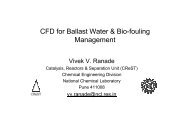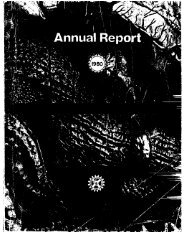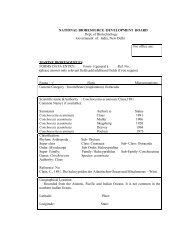Ultra Low Energy Secondary Ion Mass Spectrometry and
Ultra Low Energy Secondary Ion Mass Spectrometry and
Ultra Low Energy Secondary Ion Mass Spectrometry and
Create successful ePaper yourself
Turn your PDF publications into a flip-book with our unique Google optimized e-Paper software.
Proceedings of 12 th ISMAS Symposium cum IT-12<br />
Workshop on <strong>Mass</strong> <strong>Spectrometry</strong><br />
<strong>Ultra</strong> <strong>Low</strong> <strong>Energy</strong> <strong>Secondary</strong> <strong>Ion</strong> <strong>Mass</strong> <strong>Spectrometry</strong> <strong>and</strong> some Current<br />
Applications.<br />
Abstract<br />
R. J. H. Morris <strong>and</strong> M. G. Dowsett<br />
University of Warwick, Physics Dept, Gibbet Hill Road, Coventry, CV4 7AL, UK.<br />
From its development in the early 1960s until 1990 or so, dynamic secondary ion<br />
mass spectrometry (SIMS) routinely employed primary beam energies of 5-20 keV. In the<br />
late 1980s, dem<strong>and</strong> for depth profile analysis of semiconductor heterostructures with sharp<br />
interfaces grew rapidly. This was followed closely by the requirements of emerging<br />
semiconductor technologies dependent on shallow implantation. The beam energies then<br />
available were too high to provide adequate depth resolution in the former case, or<br />
quantitative near-surface analysis in the latter, <strong>and</strong> this drove the development of SIMS<br />
instrumentation able to work routinely with beam energies down to 250 eV. The earliest such<br />
development was the floating low energy ion gun (FLIG). The FLIG allowed primary<br />
beam energies of 0.2-1.0 keV to be used <strong>and</strong> led to the coining of the term ‘ultra low energy<br />
SIMS’ (uleSIMS).<br />
Dynamic uleSIMS profiling enables sub-nanometre depth resolution to be obtained,<br />
whilst retaining the large dynamic range <strong>and</strong> detection levels (ppm/ppb) essential in<br />
semiconductor analysis. Nevertheless, profiling at such low energies still has limitations, for<br />
example, transient behaviour at the surface <strong>and</strong> at hetero-interfaces, <strong>and</strong> the development of<br />
nanotopography if the analytical conditions are not chosen properly. A new way of using<br />
uleSIMS is in dynamic mass spectral analysis. The low primary beam energies combined<br />
with a low beam current allow for only the uppermost few nanometres of the material’s<br />
surface to be investigated, preserving chemical information, but allowing for the removal of<br />
monolayers of contamination which may be irrelevant to the problem at h<strong>and</strong> (in contrast to<br />
static SIMS). Correct interpretation of mass spectra can lead to a better underst<strong>and</strong>ing of<br />
surface chemistry. Examples of both dynamic <strong>and</strong> mass spectra uleSIMS will be given.<br />
Although uleSIMS has been extensively used in the semiconductor field, other<br />
material science disciplines are embracing it. Examples of these are as diverse as glass<br />
technology <strong>and</strong> cultural heritage research.<br />
1. Introduction<br />
The origins of many analytical techniques used today date back to end of the 19 th <strong>and</strong><br />
beginning of the 20 th centuries. For SIMS, it was J.J Thompson <strong>and</strong> his co-workers who<br />
observed the effects of ions in a discharge tube on a metal plate around this time 1 . However,<br />
it was not until 1949 before the first instrumentation capable of SIMS analysis was developed<br />
(Herzog <strong>and</strong> Vienböck) 2 , whilst the first commercial SIMS instrumentation only came to<br />
fruition in the late 1950s to early 1960s. The driving force behind the development of the<br />
commercial SIMS instrument was the need for isotopic <strong>and</strong> spatial analysis of materials<br />
brought back from NASA’s space voyages 3 . With the emergence of the semiconductor<br />
industry, SIMS became the technique for analysing the doping implants used.<br />
Initially, the semiconductor industry used high energy implantation as this was well<br />
matched to the technology of the time. Conventional SIMS analysis performed at the time<br />
used primary beam energies ≥ 5 keV. Profiling at energies ≥ 5 keV results in the initial ion<br />
12 th ISMAS-WS-2007, March 25-30, 2007, Cidade de Goa, Dona Paula, Goa
Proceedings of 12 th ISMAS Symposium cum IT-12<br />
Workshop on <strong>Mass</strong> <strong>Spectrometry</strong><br />
yields from the samples uppermost region (20-30 nm) being unstable as steady state<br />
conditions are not yet achieved 4 . When the semiconductor industry was producing devices<br />
for the ≥ 250 nm IC regime, the projected range of the implants used was > 30 nm. These ion<br />
instabilities observed within the first 20-30 nm of the SIMS profiles did not, therefore,<br />
introduce a significant error into the quantification process. However, as the semiconductor<br />
industry scaled down device dimensions (≤ 180 nm technology) in order to meet the markets<br />
dem<strong>and</strong>s for higher packing densities <strong>and</strong> microprocessor speeds, ultra low energy dopant<br />
implants were implemented. Such low energy implantation meant that a significant amount<br />
of the implanted species now resided within the 30 nm region closest to the implanted surface.<br />
As an example, a 500 eV boron implant into silicon has a projected range of approximately<br />
3 nm. In conjunction with low energy implantation, development of the growth techniques<br />
such as molecular beam epitaxy (MBE) <strong>and</strong> chemical vapour deposition (CVD) led to high<br />
quality crystalline semiconductor layers of nanometre scale being readily achieved 5 .<br />
The combination of lower energy implants <strong>and</strong> nanometre scale epitaxy meant that<br />
high energy SIMS became an inaccurate technique for quantifying these materials. This was<br />
mostly due to issues associated with the primary beam energy <strong>and</strong> its affect on the transient<br />
regions width <strong>and</strong> depth resolution achievable. For accurate dynamic SIMS analysis, it is<br />
imperative that the steady state condition for erosion rate whilst retaining a constant primary<br />
ion dose within the receding near-surface region is obtained. The transient effect occurs<br />
when this steady state condition is not met, such as in the initial part of a profile or when the<br />
primary beam passes through layers of differing matrix composition. In the case of the depth<br />
resolution, this is a measure of the ability to distinguish between different features at separate<br />
depths i.e. interfaces of multilayer structures. For sub-keV SIMS profiling (which will be<br />
discussed later) to exploit the nanometre depth resolution capabilities, a minimum of 10 data<br />
points per nm per mass analysed must be obtained 6 . In general, <strong>and</strong> given the perfect sample:<br />
the lower the primary beam energy, the smaller the transient width <strong>and</strong> the better the depth<br />
resolution obtainable.<br />
2. The development of uleSIMS<br />
To supply the semiconductor industry with the type of instruments required, the SIMS<br />
community needed to modify their equipment to work at significantly lower primary beam<br />
energies. <strong>Low</strong>er primary beam energies were finally achieved in the mid 1990s, when a<br />
complete new source based on implanter technology was built. The source was a floating<br />
low energy ion (FLIG) gun <strong>and</strong> was designed <strong>and</strong> built by Dowsett et al at the University<br />
of Warwick 7 . The FLIG enabled SIMS profiling to be carried out for energies in the range<br />
0.2-20 keV. By having a usable primary beam of energy ≤1 keV, the phrase ‘ultra low<br />
energy SIMS’ (uleSIMS) was adopted. In order for these low energies to be fully realised,<br />
new secondary ion optical collection systems had to be developed to h<strong>and</strong>le the low<br />
secondary ion emission. These were built in time to coincide with the new low energy guns,<br />
but more importantly, retained the large dynamic range <strong>and</strong> ppm/ppb detection levels<br />
previously offered with high energy SIMS. For energies between 0.2-1.0 keV, the FLIG<br />
was shown to produce beam currents <strong>and</strong> spot sizes which had only previously been<br />
obtainable at ≥ 5 keV. Figure 1 shows two profiles performed on a 16 period, 1 nm spaced,<br />
SiGe superlattice structure. The 16 period superlattice structure had been confirmed to exist<br />
via transmission electron microscopy. Both profiles were performed using identical<br />
conditions except for the incident beam energies which were 300 eV <strong>and</strong> 2 keV. For the<br />
2 keV profile, the individual SiGe layers were not resolved <strong>and</strong> from the resulting profile the<br />
12 th ISMAS-WS-2007, March 25-30, 2007, Cidade de Goa, Dona Paula, Goa
Proceedings of 12 th ISMAS Symposium cum IT-12<br />
Workshop on <strong>Mass</strong> <strong>Spectrometry</strong><br />
analyst would be left believing that it was a single SiGe layer present. In the case of the<br />
300 eV profile, the much improved depth resolution enables all the layers to be resolved 8 .<br />
Given the layer spacing, the 300 eV profile clearly demonstrates the nanometre depth<br />
resolution achievable with the new FLIG technology. Further experiments also found that<br />
for a 300 eV primary O2 + beam, a transient width of approximately 0.4 nm was obtained 9 .<br />
This scale of transient width cannot always be achieved as material parameters (e.g. surface<br />
topography) or profile conditions required may be a restricting factor. Experiments have<br />
been undertaken to try <strong>and</strong> obtain a better underst<strong>and</strong>ing of the transient regions error by<br />
profiling capped <strong>and</strong> uncapped implants 10 . The overall aim of this research would be to<br />
generate models in order to predict the transient behaviour, enabling its affects to be taken<br />
into account when quantifying the profile.<br />
The FLIG was not the only uleSIMS technology developed in the 1990s. Competing<br />
developments were those of Kratos 11 <strong>and</strong> CAMECA 12 with floating extraction systems for<br />
magnetic sector technologies, <strong>and</strong> the dual beam ToF system from Benninghoven’s group 13 .<br />
(References from SIMS VIII <strong>and</strong> SIMS X)<br />
3. uleSIMS applications<br />
Although SIMS/uleSIMS as been primarily driven in the last 30 to 40 years by the<br />
semiconductor industry, there are now other material disciplines which have come to adopt it.<br />
Examples of these are glass corrosion 14 <strong>and</strong> more recently cultural heritage 15 . In the case of<br />
glass, experimental research has been performed on corrosion of museum pieces 16 <strong>and</strong> glass<br />
used for nuclear waste containment 17 . The main influence on the speed of glass corrosion is<br />
the ambient storage conditions. As an example of the types of studies ongoing, figures 2a<br />
<strong>and</strong> b show a 1 keV Cs + SIMS profile of a glass sample aged at 40% relative humidity <strong>and</strong><br />
room temperature for 9 days 18 . It was found from the profile (figure 2a) that the glass near to<br />
the surface had become hydrated due to its exposure to atmospheric moisture. The increased<br />
hydrogen <strong>and</strong> decreased sodium levels within this near surface region indicate that ion<br />
exchange has occurred. Although this in itself is important information, the ability to profile<br />
at such low energies enabled the sharp gradient between the hydrated layer <strong>and</strong> bulk glass<br />
(figure 2b) to be resolved <strong>and</strong> analysed. This analysis showed that the diffusion coefficient<br />
had a strong dependence on the diffusing species concentration.<br />
A more recent application of uleSIMS has been in the field of cultural heritage.<br />
Cultural heritage has in the past used static SIMS (SSIMS) for investigating the surface of<br />
relatively old materials in order to obtain molecule specific information 19 . SSIMS may well<br />
yield information regarding the surface of a material but in many instances, especially where<br />
corrosion is concerned, the information required may be several nanometres below the<br />
surface contamination or polish residue. In our work we have shown that uleSIMS analysis<br />
shows great potential as an analytical technique for this type of research 20 . By using the very<br />
low energies offered combined with low beam currents, the uppermost few nanometres of the<br />
sample can be sputtered whilst collecting the mass spectra information required. By taking<br />
several measurements consecutively, an isotopic fingerprint analysis of the near surface<br />
region can be built up. Figure 3 shows mass spectra taken from a silver coupon sample using<br />
a 500 eV, 10 nA, 30° O2 + primary beam with a raster area of 1 mm square. The silver had<br />
been polished using ‘Tripoli’ (a polishing compound) used to mimic the properties of crushed<br />
limestone <strong>and</strong> was then left to age for 2 years in a glass cabinet at the Swiss national museum.<br />
From the spectra, the lighter bars show the isotopic masses present at the surface whilst the<br />
darker bars are the data taken some 35 µm into the silver coupon. From the resulting profiles,<br />
12 th ISMAS-WS-2007, March 25-30, 2007, Cidade de Goa, Dona Paula, Goa
Proceedings of 12 th ISMAS Symposium cum IT-12<br />
Workshop on <strong>Mass</strong> <strong>Spectrometry</strong><br />
the spectra indicate that the Tripoli leaves complex silicate residues embedded in the near<br />
surface of the material <strong>and</strong> the many peaks observed between 50-60 Da are due to this. Both<br />
electron microscopy <strong>and</strong> deeper analyses substantiate this conclusion. From mass spectra<br />
using negative ion collection (500 eV, 10 nA Cs + at 50° from normal), again scanned over a<br />
1 mm square area, large amounts of Cu <strong>and</strong> Ag sulphides were found. This type of<br />
information enables a broad picture of the cleaning procedures <strong>and</strong> their effects to be built up<br />
<strong>and</strong> will help in the development of non-corrosive cleaning techniques <strong>and</strong> preservative<br />
coatings in the future.<br />
4. Conclusion<br />
SIMS has existed since the late 1940s. Its initial development as a commercial<br />
technique was through NASA’s drive to analyse materials it was collecting from its space<br />
voyages more than a decade later. As microelectronics became commercially feasible, SIMS<br />
was quickly adopted as the tool to inform the refinement of doping processes. As the<br />
technology approached the 100 nm scale SIMS analysis at ≥ 5 keV which had been<br />
previously employed lacked sufficient depth resolution <strong>and</strong> was unable to obtain data in the<br />
top 10-20 nm. These problems were overcome (to a large extent) by the introduction of<br />
instrumentation capable of delivering sub-keV ion beams with sufficient current density for<br />
routine nm-resolution depth-profiling with transient widths as small as 0.4 nm. Just as<br />
importantly, the new secondary ion optics developed to deal with the low energy secondary<br />
ion sputtering retained the large dynamic range <strong>and</strong> high detection sensitivities. The high<br />
resolution spatial <strong>and</strong> isotopic mass analysis offered by uleSIMS is now being applied in<br />
other research fields. Examples of this are investigation of glass corrosion mechanisms <strong>and</strong>,<br />
more recently, cultural heritage <strong>and</strong> conservation. Here, ule dynamic SIMS is complementary<br />
to static SIMS which has been used for some time. Such features include the ability to build<br />
up a mass profile not only of the surface but also the several nanometres below. This enables<br />
information to be obtained on, for example, corrosion effects occurring below the polished or<br />
atmospherically contaminated surface to be investigated.<br />
References<br />
[1] J. J. Thompson, Phil. Mag., 20, (1910), 252.<br />
[2] R.F.K. Herzog <strong>and</strong> F. Viehböck ., Phys. Rev., 76, (1949), 855.<br />
[3] R.F.K. Herzog, W.P. Poschenreider <strong>and</strong> F.G. Satkiewicz, NASA, Contract No<br />
NAS5-9254, final report GCA-TR-67-3N, (1967).<br />
[4] V.K.F. Chia, G.R. Mount <strong>and</strong> M.J. Edgell,. J. Vac. Sci. B, 17, (1999), 2345.<br />
[5] C.K. Maiti <strong>and</strong> G.A. Armstrong., “Applications of silicon-germanium Heterostructure<br />
Devices”, IoP Publishing, (2001).<br />
[6] M.G. Dowsett <strong>and</strong> R. Collins, Phil. Trans. R. Soc. London A 354 (1996), 2713.<br />
[7] M.G. Dowsett, N.S. Smith, R. Bridgel<strong>and</strong>, D. Richards, A.C. Lovejoy, P. Pedrick.<br />
Proceeding of SIMS X, (1995), 367-370.<br />
[8] N.S. Smith, M.G. Dowsett, B. McGegor <strong>and</strong> P. Phillips, Proceedings of SIMS X, (1995),<br />
363-366.<br />
[9] M.G. Dowsett, G.A. Cooke, D.I. Elliner, T.J. Ormsby <strong>and</strong> A. Murrell, Proceedings of<br />
SIMS XI, (1997), 285-288.<br />
[10] J. Bellingham, M.G. Dowsett, E. Collart <strong>and</strong> D. Kirkwood. Appl. Surf. Sci. 203-204,<br />
(2003), 851-854.<br />
12 th ISMAS-WS-2007, March 25-30, 2007, Cidade de Goa, Dona Paula, Goa
Proceedings of 12 th ISMAS Symposium cum IT-12<br />
Workshop on <strong>Mass</strong> <strong>Spectrometry</strong><br />
[11] S.P. Thompson, M.G. Dowsett, J.L. Wilkes, N.A. Fairley, C.A. Corlett, J. Nuttall, D.<br />
Finbow, B.W. Griffiths, P. Blenkinsop <strong>and</strong> S.J. Mullock. Proceeding of SIMS VIII, (1991),<br />
183-186.<br />
[12] E. Chambost, F. Hillion, B. Rasser <strong>and</strong> H.N. Migeon. Proceeding of SIMS VIII, (1991),<br />
207-210.<br />
[13] K. Iltgen, C. Bendel, E. Niehuis <strong>and</strong> A. Benninghoven. Proceeding of SIMS X, (1995),<br />
375-378.<br />
[14] V. Oakley, Glass Tech. 42, (2001), 65-69.<br />
[15] M.G. Dowsett <strong>and</strong> A.Adriaens. Nucl. Inst. Methods B, 226, 2004, 38-52<br />
[16] S. Fearn, D.S. McPhail <strong>and</strong> V. Oakley. Appl Surf Sci, 232-232, (2004), 510-514.<br />
[17] G.G. Wicks, in: D.E. Clarke, B.K. Zoitos (Eds.), “Corrosion of Glass, Ceramics <strong>and</strong><br />
Superconductors”, Noyes Publication, 1991.<br />
[18] S. Fearn, D.S. McPhail, R.J.H. Morris, M.G. Dowsett, Appl Surf Sci, 252, (2006),<br />
7070-7073.<br />
[19] A.Adriaens <strong>and</strong> M.G.Dowsett., Applied Surface Science 252 (2006) 7096-7101.<br />
[20] M.G.Dowsett, A. Adriaens, M. Soares, H. Wouters, V.V.N. Palitsin, R. Gibbons <strong>and</strong><br />
R.J.H. Morris. Nucl. Inst. Methods B, 239, 2005, 51-64.<br />
Figure 1. 300 eV <strong>and</strong> 2 keV SIMS profiles of a 16 period Si/SiGe superlattice structure.<br />
After [8].<br />
Figure 2. (a) Cs SIMS depth profile of a glass sample aged at 40% RH <strong>and</strong> room temperature<br />
for 9 days <strong>and</strong> (b) the quantified depth profile of the same sample. After [18].<br />
12 th ISMAS-WS-2007, March 25-30, 2007, Cidade de Goa, Dona Paula, Goa
Proceedings of 12 th ISMAS Symposium cum IT-12<br />
Workshop on <strong>Mass</strong> <strong>Spectrometry</strong><br />
Figure 3. (a) Positive uleSIMS ion spectrum from the surface of a sterling silver coupon<br />
(grey bars) polished with ‘Tripoli’ <strong>and</strong> aged 2 years at the Swiss National museum. Also<br />
shown (black bars) is a positive ion spectrum taken using a stationary 50 µm diameter beam<br />
from a depth of ~35 µm into the silver coupon. (b) Negative ion spectra from the tarnished<br />
surface (grey bars) <strong>and</strong> following a cleaning dose of 1.8×10 18 ions cm -2 . After [20]<br />
12 th ISMAS-WS-2007, March 25-30, 2007, Cidade de Goa, Dona Paula, Goa
Proceedings of 12 th ISMAS Symposium cum IT-12<br />
Workshop on <strong>Mass</strong> <strong>Spectrometry</strong><br />
Dr. Richard Morris received his PhD in physics from the University<br />
of Warwick, UK. After finishing his doctoral studies he secured a<br />
permanent research fellow position within the Department of Physics<br />
at the University of Warwick. His early research work was in the<br />
silicon germanium semiconductor field <strong>and</strong> involved the growth <strong>and</strong><br />
strain optimisation of germanium layers with device integration in<br />
mind. This work was carried out as silicon technology was embracing<br />
the enhancements offered by germanium incorporation. His current<br />
research area is in the field of SIMS <strong>and</strong> involves many different<br />
aspects of the technique applied to various types of materials. From this research, the<br />
development of an optical method to overcome problems faced when trying to accurately<br />
profile highly resistive semiconductor layers was achieved. This is now marketed by one of<br />
the main SIMS instrument suppliers. From his research, numerous publications <strong>and</strong> talks<br />
have been presented across both the semiconductor <strong>and</strong> SIMS fields.<br />
12 th ISMAS-WS-2007, March 25-30, 2007, Cidade de Goa, Dona Paula, Goa








